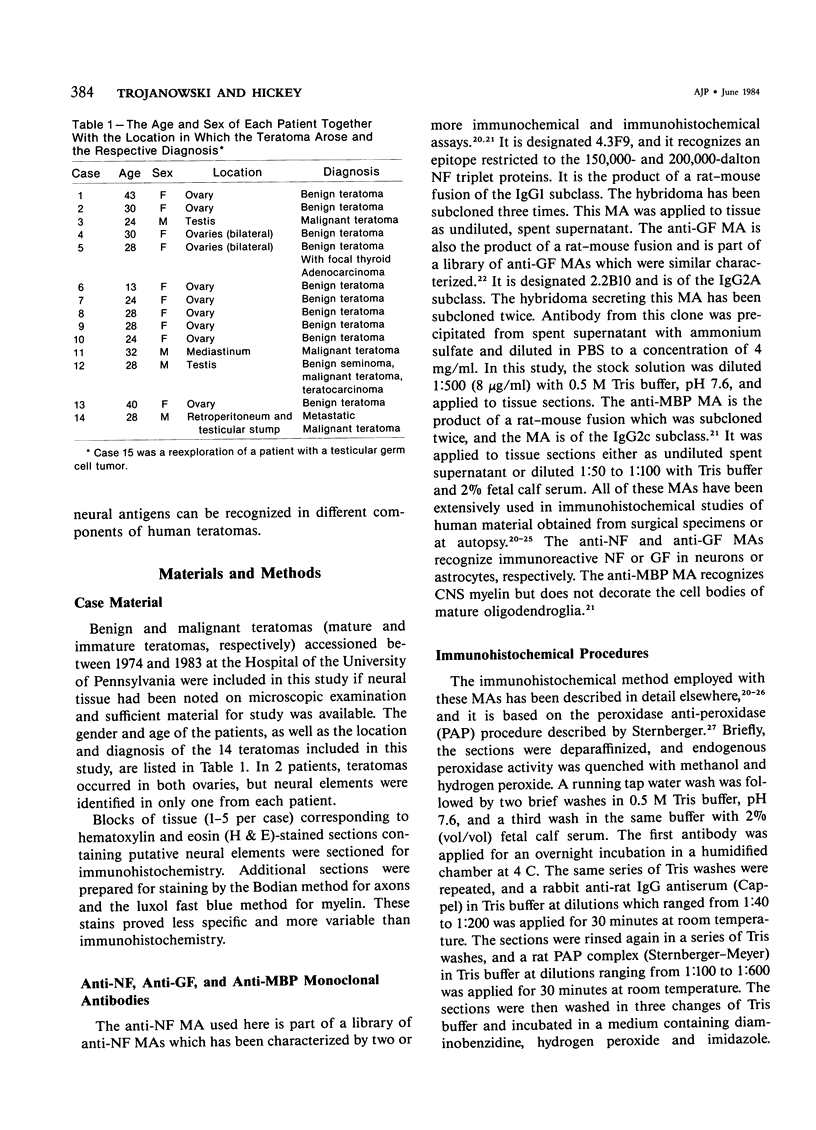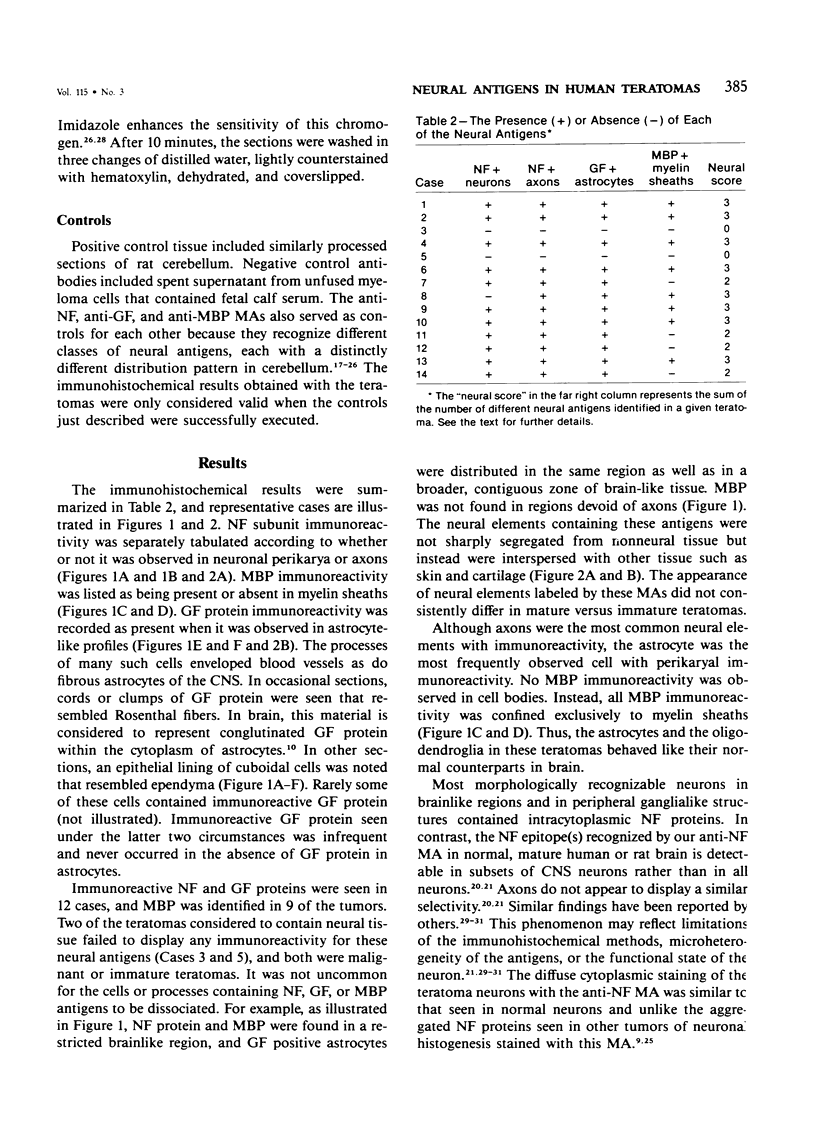Abstract
Monoclonal antibodies specific for neurofilament proteins, glial filament protein, or myelin basic protein were used with immunohistochemistry for evaluation of a series of 14 human benign and malignant teratomas for the presence of these neural specific antigens. The results indicate that human teratomas can express all of these neural antigens, reflecting the presence of differentiated neurons, astrocytes, and oligodendroglia, respectively. Although the tumors were selected because neural tissue had been noted on microscopic examination, 2 of the 15 cases lacked all of these neural antigens, and both were malignant teratomas. In the remaining cases, 2 or 3 of these neural antigens were detected. The presence of all 3 was correlated with the presence of mature, and the absence of immature, neural elements. The immunohistochemical detection of these antigens allows the confident recognition of neural elements in human teratomas, and their presence may be of prognostic significance.
Full text
PDF






Images in this article
Selected References
These references are in PubMed. This may not be the complete list of references from this article.
- Aguirre P., Scully R. E. Malignant neuroectodermal tumor of the ovary, a distinctive form of monodermal teratoma: report of five cases. Am J Surg Pathol. 1982 Jun;6(4):283–292. doi: 10.1097/00000478-198206000-00001. [DOI] [PubMed] [Google Scholar]
- Bignami A., Raju T., Dahl D. Localization of vimentin, the nonspecific intermediate filament protein, in embryonal glia and in early differentiating neurons. In vivo and in vitro immunofluorescence study of the rat embryo with vimentin and neurofilament antisera. Dev Biol. 1982 Jun;91(2):286–295. doi: 10.1016/0012-1606(82)90035-5. [DOI] [PubMed] [Google Scholar]
- Brostoff S. W., Eylar E. H. The proposed amino acid sequence of the P1 protein of rabbit sciatic nerve myelin. Arch Biochem Biophys. 1972 Dec;153(2):590–598. doi: 10.1016/0003-9861(72)90377-3. [DOI] [PubMed] [Google Scholar]
- Brostoff S. W., Karkhanis Y. D., Carlo D. J., Reuter W., Eylar E. H. Isolation and partial characterization of the major proteins of rabbit sciatic nerve myelin. Brain Res. 1975 Mar 28;86(3):499–458. doi: 10.1016/0006-8993(75)90895-1. [DOI] [PubMed] [Google Scholar]
- Dahl D., Chi N. H., Miles L. E., Nguyen B. T., Bignami A. Glial fibrillary acidic (GFA) protein in Schwann cells: fact or artifact? J Histochem Cytochem. 1982 Sep;30(9):912–918. doi: 10.1177/30.9.6182187. [DOI] [PubMed] [Google Scholar]
- Darmon M., Buc-Caron M. H., Paulin D., Jacob F. Control by the extracellular environment of differentiation pathways in 1003 embryonal carcinoma cells: study at the level of specific intermediate filaments. EMBO J. 1982;1(8):901–906. doi: 10.1002/j.1460-2075.1982.tb01269.x. [DOI] [PMC free article] [PubMed] [Google Scholar]
- Dräger U. C. Coexistence of neurofilaments and vimentin in a neurone of adult mouse retina. Nature. 1983 May 12;303(5913):169–172. doi: 10.1038/303169a0. [DOI] [PubMed] [Google Scholar]
- Fenoglio C. M., Tlamsa G., Habif D. V. Pituitary-containing benign cystic teratoma of the ovary in a patient with metastatic breast cancer: a case report. Diagn Histopathol. 1982 Apr-Jun;5(2):143–150. [PubMed] [Google Scholar]
- Goldstein M. E., Sternberger L. A., Sternberger N. H. Microheterogeneity ("neurotypy") of neurofilament proteins. Proc Natl Acad Sci U S A. 1983 May;80(10):3101–3105. doi: 10.1073/pnas.80.10.3101. [DOI] [PMC free article] [PubMed] [Google Scholar]
- Goldstein M. E., Sternberger N. H., Sternberger L. A. Developmental expression of neurotypy revealed by immunocytochemistry with monoclonal antibodies. J Neuroimmunol. 1982 Nov;3(3):203–217. doi: 10.1016/0165-5728(82)90023-6. [DOI] [PubMed] [Google Scholar]
- Goodfellow P. N., Andrews P. W. The biology of teratocarcinomas. Nature. 1982 Nov 11;300(5888):107–108. doi: 10.1038/300107a0. [DOI] [PubMed] [Google Scholar]
- Graham D. I., Thomas D. G., Brown I. Invited review. Nervous system antigens. Histopathology. 1983 Jan;7(1):1–21. doi: 10.1111/j.1365-2559.1983.tb02212.x. [DOI] [PubMed] [Google Scholar]
- Hickey W. F., Lee V., Trojanowski J. Q., McMillan L. J., McKearn T. J., Gonatas J., Gonatas N. K. Immunohistochemical application of monoclonal antibodies against myelin basic protein and neurofilament triple protein subunits: advantages over antisera and technical limitations. J Histochem Cytochem. 1983 Sep;31(9):1126–1135. doi: 10.1177/31.9.6193166. [DOI] [PubMed] [Google Scholar]
- Jones-Villeneuve E. M., McBurney M. W., Rogers K. A., Kalnins V. I. Retinoic acid induces embryonal carcinoma cells to differentiate into neurons and glial cells. J Cell Biol. 1982 Aug;94(2):253–262. doi: 10.1083/jcb.94.2.253. [DOI] [PMC free article] [PubMed] [Google Scholar]
- Landrieu P., Goffinet A., Caviness V., Lyon G. Formation of "neo-cortex" in a congenital human teratoma. Acta Neuropathol. 1981;55(1):35–38. doi: 10.1007/BF00691528. [DOI] [PubMed] [Google Scholar]
- Lazarides E. Intermediate filaments: a chemically heterogeneous, developmentally regulated class of proteins. Annu Rev Biochem. 1982;51:219–250. doi: 10.1146/annurev.bi.51.070182.001251. [DOI] [PubMed] [Google Scholar]
- Lee V. M., Page C. D., Wu H. L., Schlaepfer W. W. Monoclonal antibodies to gel-excised glial filament protein and their reactivities with other intermediate filament proteins. J Neurochem. 1984 Jan;42(1):25–32. doi: 10.1111/j.1471-4159.1984.tb09692.x. [DOI] [PubMed] [Google Scholar]
- Lee V., Trojanowski J. Q., Schlaepfer W. W. Induction of neurofilament triplet proteins in PC12 cells by nerve growth factor. Brain Res. 1982 Apr 22;238(1):169–180. doi: 10.1016/0006-8993(82)90779-x. [DOI] [PubMed] [Google Scholar]
- Lee V., Wu H. L., Schlaepfer W. W. Monoclonal antibodies recognize individual neurofilament triplet proteins. Proc Natl Acad Sci U S A. 1982 Oct;79(19):6089–6092. doi: 10.1073/pnas.79.19.6089. [DOI] [PMC free article] [PubMed] [Google Scholar]
- Miettinen M., Lehto V. P., Virtanen I. Expression of intermediate filaments in normal ovaries and ovarian epithelial, sex cord-stromal, and germinal tumors. Int J Gynecol Pathol. 1983;2(1):64–71. doi: 10.1097/00004347-198301000-00006. [DOI] [PubMed] [Google Scholar]
- Moss T. H., Lewkowicz S. J. The axon reaction in motor and sensory neurones of mice studied by a monoclonal antibody marker of neurofilament protein. J Neurol Sci. 1983 Aug;60(2):267–280. doi: 10.1016/0022-510x(83)90068-0. [DOI] [PubMed] [Google Scholar]
- Pruss R. M., Mirsky R., Raff M. C., Thorpe R., Dowding A. J., Anderton B. H. All classes of intermediate filaments share a common antigenic determinant defined by a monoclonal antibody. Cell. 1981 Dec;27(3 Pt 2):419–428. doi: 10.1016/0092-8674(81)90383-4. [DOI] [PubMed] [Google Scholar]
- Raff M. C., Miller R. H., Noble M. A glial progenitor cell that develops in vitro into an astrocyte or an oligodendrocyte depending on culture medium. Nature. 1983 Jun 2;303(5916):390–396. doi: 10.1038/303390a0. [DOI] [PubMed] [Google Scholar]
- Ramaekers F. C., Puts J. J., Moesker O., Kant A., Huysmans A., Haag D., Jap P. H., Herman C. J., Vooijs G. P. Antibodies to intermediate filament proteins in the immunohistochemical identification of human tumours: an overview. Histochem J. 1983 Jul;15(7):691–713. doi: 10.1007/BF01002988. [DOI] [PubMed] [Google Scholar]
- Ramsay P. B., VandenBerg S. R., Eng L. F., Herman M. M., Rubinstein L. J. Immunologic recognition of cell surface antigens in normal mouse neural tissues and in neuroepithelial cells of the OTT-6050 mouse teratoma. A radiometric, gel electrophoretic and morphologic (immunofluorescence and immunoperoxidase) study. Acta Neuropathol. 1982;56(3):214–224. doi: 10.1007/BF00690638. [DOI] [PubMed] [Google Scholar]
- Robboy S. J., Scully R. E. Ovarian teratoma with glial implants on the peritoneum. An analysis of 12 cases. Hum Pathol. 1970 Dec;1(4):643–653. doi: 10.1016/s0046-8177(70)80062-4. [DOI] [PubMed] [Google Scholar]
- Rungger-Brändle E., Gabbiani G. The role of cytoskeletal and cytocontractile elements in pathologic processes. Am J Pathol. 1983 Mar;110(3):361–392. [PMC free article] [PubMed] [Google Scholar]
- Russell P., Painter D. M. The pathological assessment of ovarian neoplasms V: The germ cell tumours. Pathology. 1982 Jan;14(1):47–72. doi: 10.3109/00313028209069042. [DOI] [PubMed] [Google Scholar]
- Sternberger N. H., Itoyama Y., Kies M. W., Webster H deF Immunocytochemical method to identify basic protein in myelin-forming oligodendrocytes of newborn rat C.N.S. J Neurocytol. 1978 Apr;7(2):251–263. doi: 10.1007/BF01217922. [DOI] [PubMed] [Google Scholar]
- Straus W. Imidazole increases the sensitivity of the cytochemical reaction for peroxidase with diaminobenzidine at a neutral pH. J Histochem Cytochem. 1982 May;30(5):491–493. doi: 10.1177/30.5.6176617. [DOI] [PubMed] [Google Scholar]
- Tapscott S. J., Bennett G. S., Toyama Y., Kleinbart F., Holtzer H. Intermediate filament proteins in the developing chick spinal cord. Dev Biol. 1981 Aug;86(1):40–54. doi: 10.1016/0012-1606(81)90313-4. [DOI] [PubMed] [Google Scholar]
- Tascos N. A., Parr J., Gonatas N. K. Immunocytochemical study of the glial fibrillary acidic protein in human neoplasms of the central nervous system. Hum Pathol. 1982 May;13(5):454–458. doi: 10.1016/s0046-8177(82)80028-2. [DOI] [PubMed] [Google Scholar]
- Trojanowski J. Q., Lee V. M. Anti-neurofilament monoclonal antibodies: reagents for the evaluation of human neoplasms. Acta Neuropathol. 1983;59(2):155–158. doi: 10.1007/BF00691603. [DOI] [PubMed] [Google Scholar]
- Trojanowski J. Q., Lee V. M. Monoclonal and polyclonal antibodies against neural antigens: diagnostic applications for studies of central and peripheral nervous system tumors. Hum Pathol. 1983 Apr;14(4):281–285. doi: 10.1016/s0046-8177(83)80111-7. [DOI] [PubMed] [Google Scholar]
- Trojanowski J. Q., Lee V. M., Schlaepfer W. W. An immunohistochemical study of human central and peripheral nervous system tumors, using monoclonal antibodies against neurofilaments and glial filaments. Hum Pathol. 1984 Mar;15(3):248–257. doi: 10.1016/s0046-8177(84)80188-4. [DOI] [PubMed] [Google Scholar]
- Trojanowski J. Q., Lee V., Pillsbury N., Lee S. Neuronal origin of human esthesioneuroblastoma demonstrated with anti-neurofilament monoclonal antibodies. N Engl J Med. 1982 Jul 15;307(3):159–161. doi: 10.1056/NEJM198207153070305. [DOI] [PubMed] [Google Scholar]
- Trojanowski J. Q., Obrocka M. A., Lee V. M. A comparison of eight different chromogen protocols for the demonstration of immunoreactive neurofilaments or glial filaments in rat cerebellum using the peroxidase-antiperoxidase method and monoclonal antibodies. J Histochem Cytochem. 1983 Oct;31(10):1217–1223. doi: 10.1177/31.10.6350434. [DOI] [PubMed] [Google Scholar]




